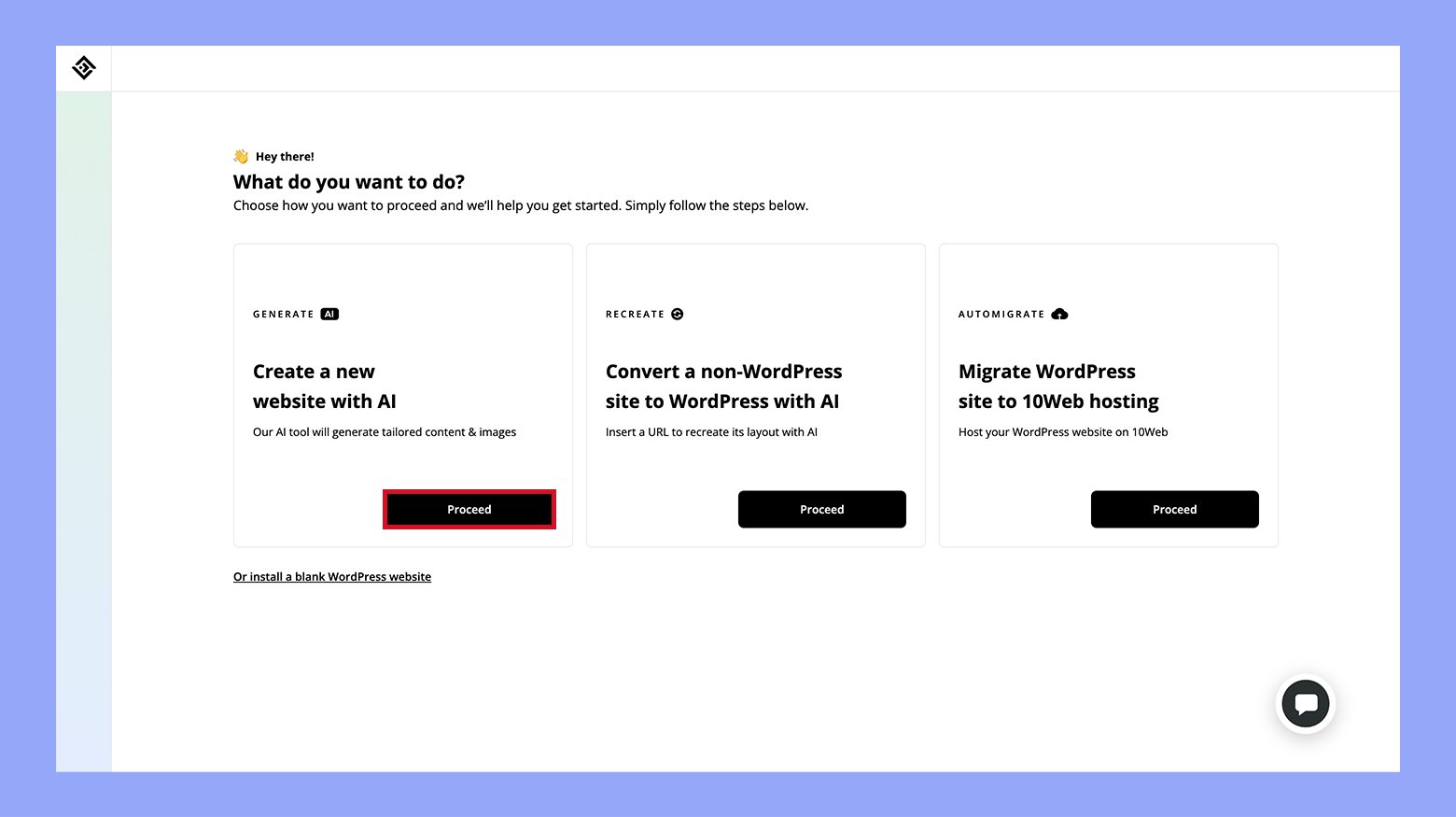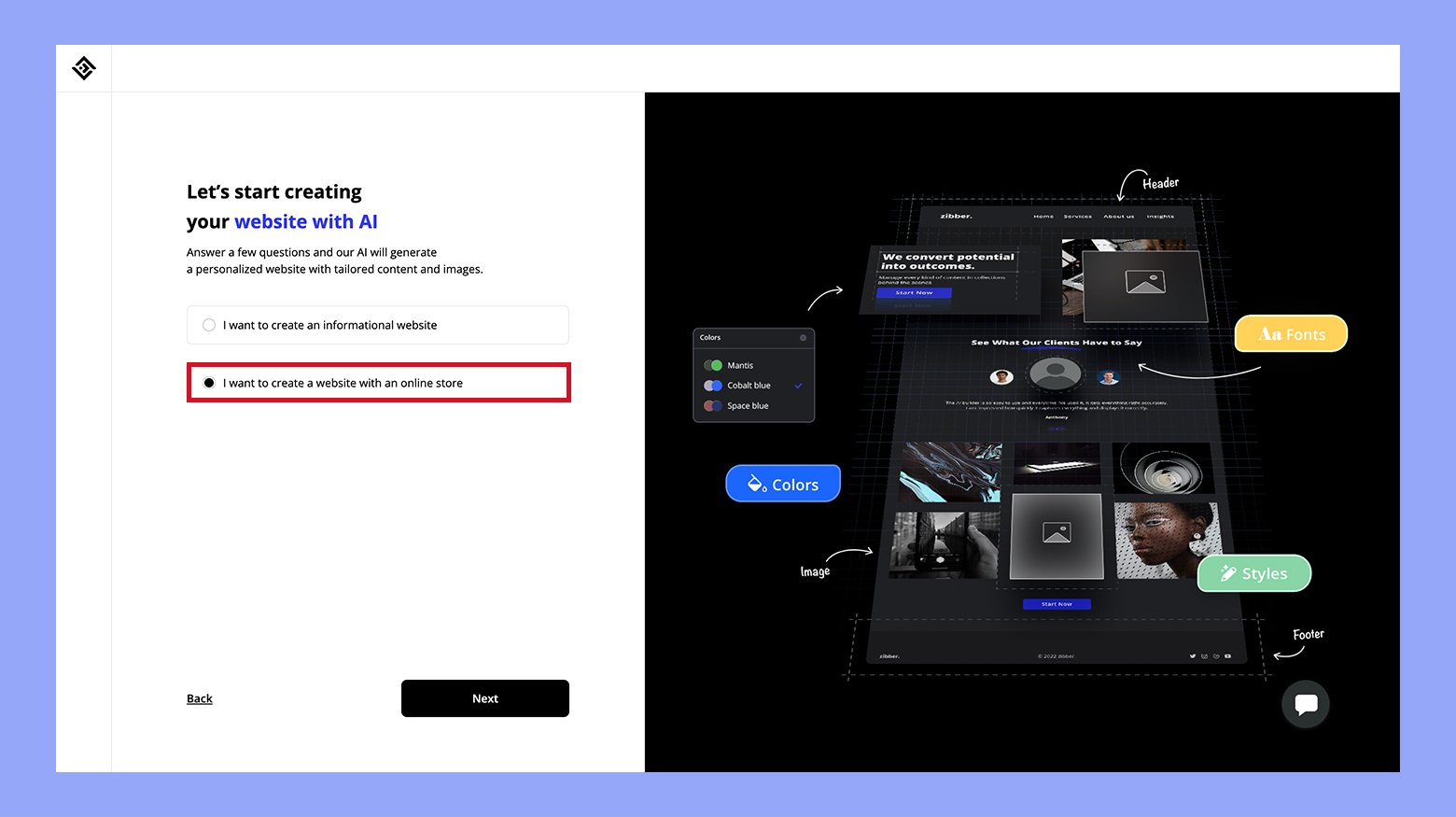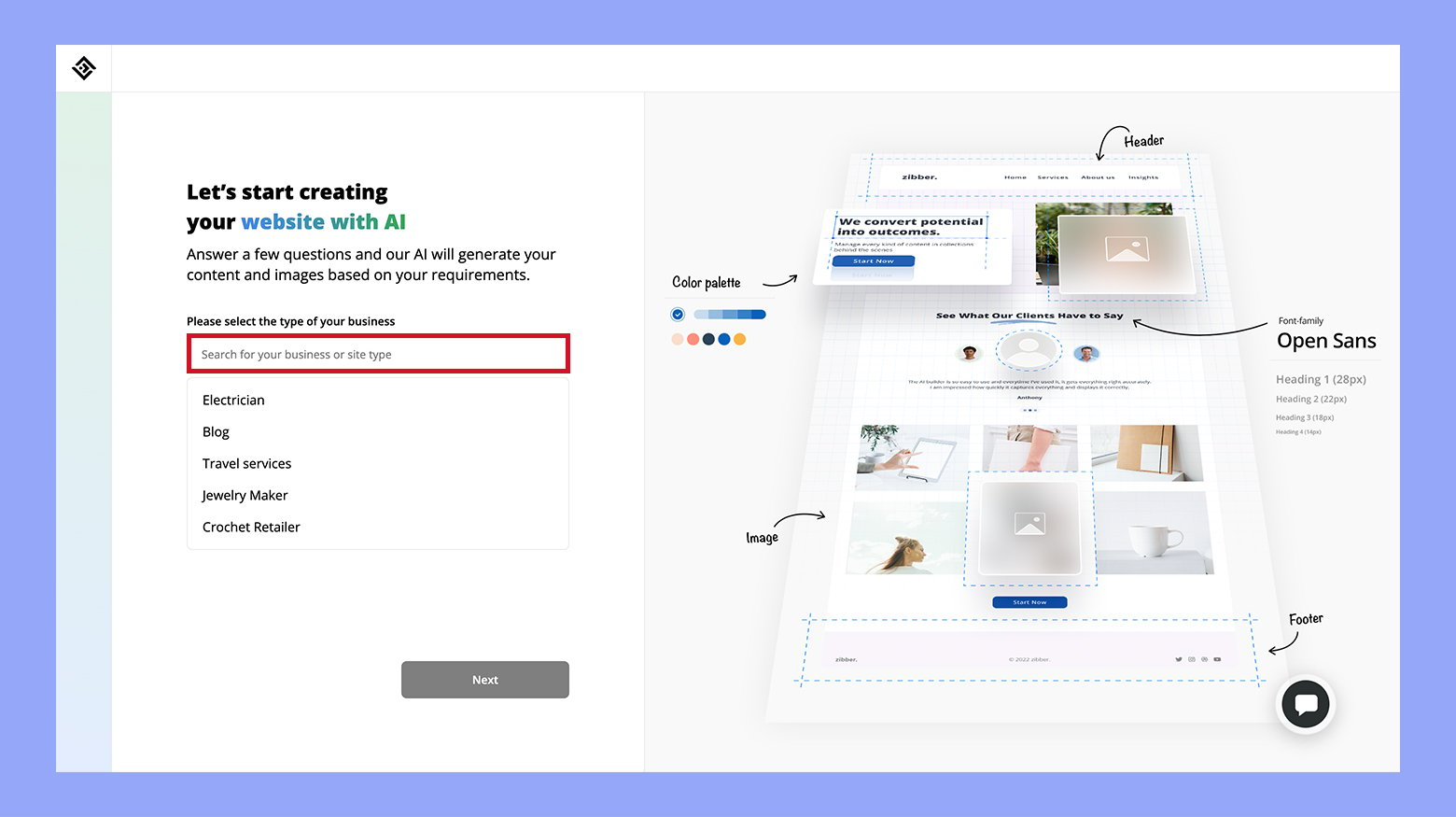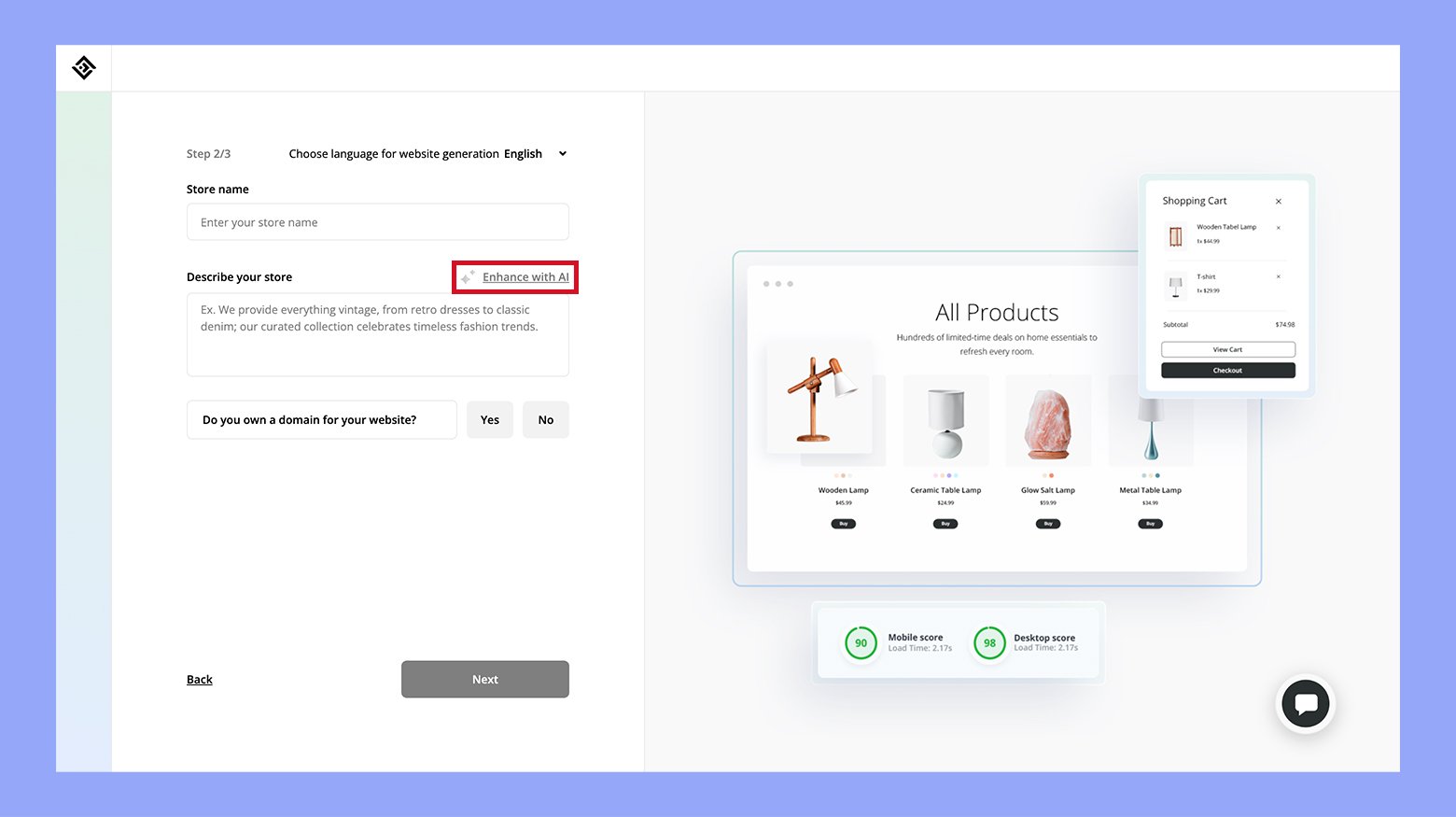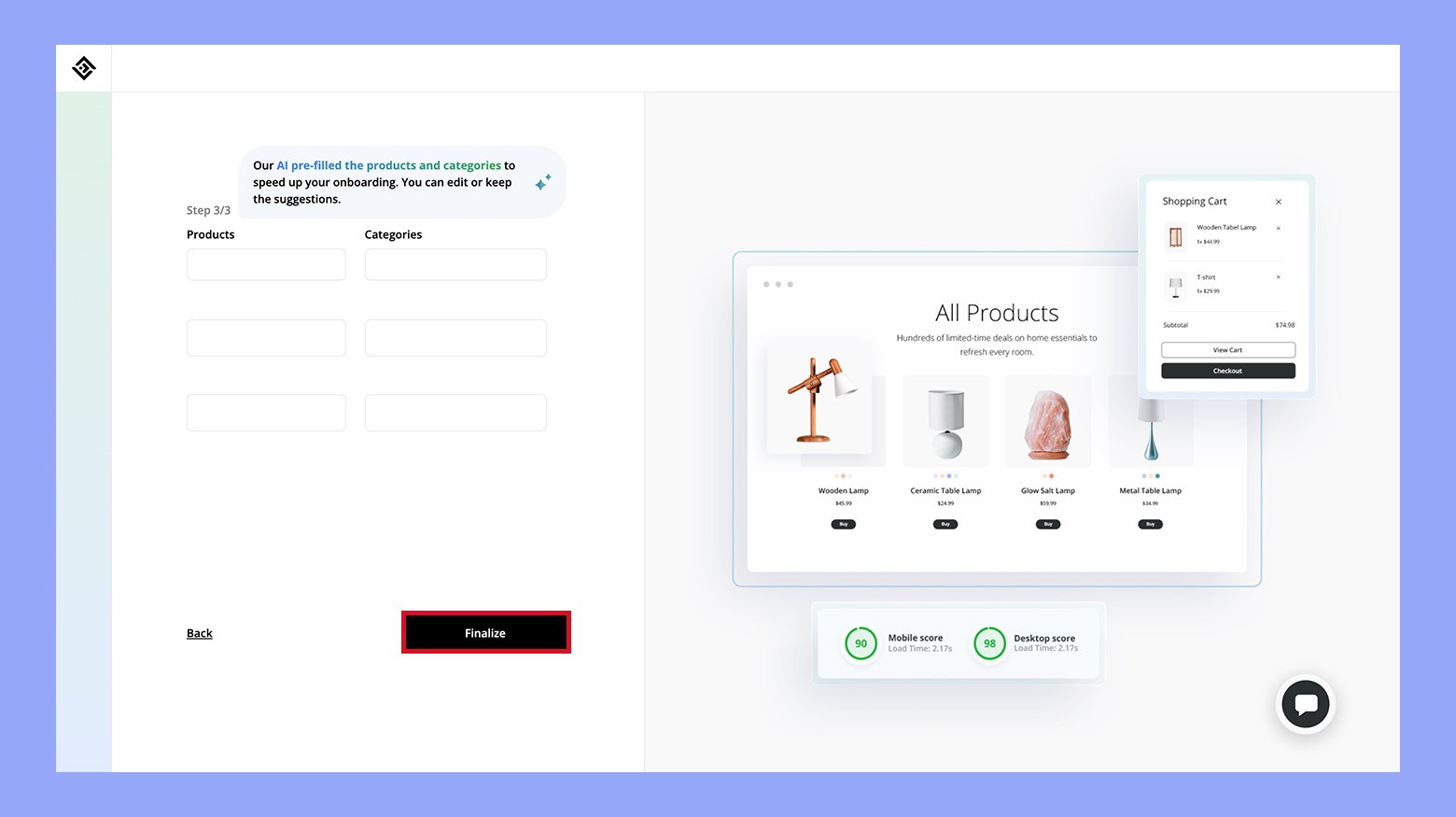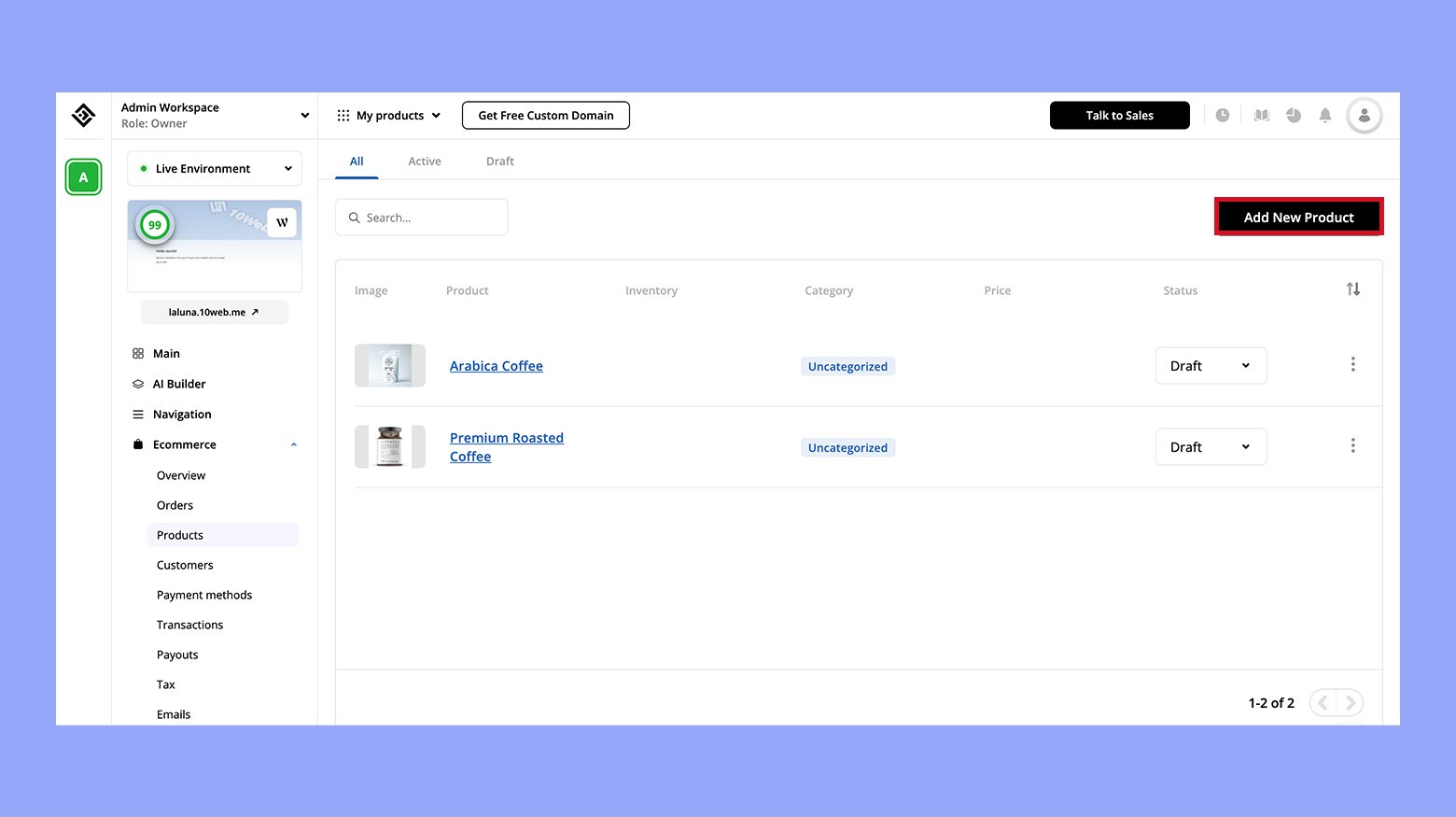Starting an online coffee business can be a highly profitable venture. With more people shopping online and seeking high-quality, specialty coffees, the market is ripe for entrepreneurs like you. To sell coffee online successfully, you need to identify your target audience and choose the right products.
Besides sourcing great coffee, think about expanding your offerings. Consider selling related products like mugs, t-shirts, and other coffee-themed items. You can also decide whether you want to focus on dropshipping, roasting your own beans, using a private label supplier, or a combination of these methods.
Setting up your online store is easier than ever with various e-commerce platforms available. Investing time in creating a user-friendly website and engaging through social media will help attract and retain customers.
FAQ
Can selling coffee online be profitable?
Do I need FDA approval to sell coffee online?
Is coffee good to sell online?
Is there money in selling coffee?

Understanding the coffee market
The coffee market is vast and growing. With over 150 million Americans drinking coffee daily, the demand is high. To successfully sell coffee online, you need to know who your customers are.
First, identify your target market. Are you focusing on casual drinkers, coffee connoisseurs, or office supplies? Each group has different needs and preferences.
Demographics can help you tailor your approach. For instance, younger audiences might prefer trendy, eco-friendly options, while older consumers may seek out traditional blends.
Next, study coffee trends. Specialty coffees and sustainable practices are becoming more popular. Understanding these trends can give you a competitive advantage.
Market research is key. Look at competitors and see what’s working for them. Tools like Google Trends or market reports can provide valuable insights.
Customer behavior can guide your decisions. For example, some consumers prefer subscription services for a regular coffee supply. Catering to these habits can boost your sales.
Your location also matters. Certain regions might favor different types of coffee. Knowing these local preferences can help you adjust your offerings.
Use online reviews and feedback to improve. Keep an eye on customer reviews to understand what they like or dislike about your products. This can help you improve and adapt.
Lastly, remember the value of branding. A strong, recognizable brand helps build customer loyalty. Consider how your branding aligns with your target market and make any necessary adjustments.
By understanding the coffee market, you can better position your products and meet the demands of your customers.
Defining your online coffee brand
To sell coffee online, you need to clearly define your brand. This involves understanding who your customers are and what sets your coffee apart from others available on the market.
Identifying your target audience
Identifying your target audience is vital. Start by considering who your ideal customers are. Are they young professionals looking for a quick caffeine boost? Are they coffee connoisseurs who value unique blends? Or perhaps they are environmentally conscious consumers seeking sustainably sourced beans.
Once you have a clear picture, use demographics (age, gender, location) and psychographics (lifestyle, interests) to refine your audience. Conducting surveys or researching online trends can provide further insights. Tailoring your marketing to this specific group increases relevance and engagement.
Creating a unique selling proposition
Your Unique Selling Proposition (USP) is what sets your coffee brand apart. Maybe it’s the quality of your beans or your sustainable farming practices. Perhaps it’s the convenience of your subscription service or your exotic blends that can’t be found anywhere else.
Clearly define your USP in a way that resonates with your target audience. Use compelling language and visuals on your website and marketing materials to highlight this aspect of your brand. Be consistent in your messaging to build a strong and recognizable brand identity.
Sourcing and roasting coffee
Sourcing high-quality coffee beans and developing unique blends are crucial steps in creating a successful online coffee business. It requires a careful selection process and creative mixing of flavors.
Finding quality coffee suppliers
Look for suppliers who provide high-quality, ethically-sourced beans. Direct trade and fair trade are strong indicators of quality and sustainability. Explore online platforms like Algrano where producers and roasters connect directly, ensuring transparency and a better price for both parties. Check reviews and ask for samples before making large purchases.
Build relationships with multiple suppliers to ensure a steady supply and variety. Attend coffee trade shows and network with other roasters to find hidden gems. Always consider the origin, altitude, and processing method as these factors significantly impact the taste of the coffee.
Developing your coffee blends
Start by identifying the flavor profiles you want to achieve. Experiment with beans from different regions to create a balanced blend. Use beans with complementary flavors, such as a rich, chocolatey base with a fruity, acidic highlight.
Roast small batches to test how different beans interact. Keep detailed notes on roast levels and flavor outcomes. Share these samples with trusted taste-testers for feedback. Once you find a winning combination, scale up the roasting process while maintaining consistency.
Investing in a quality roaster and proper training ensures you get the best results. Regularly evaluate your blends and be open to adjustments based on customer feedback.
Creating a product catalog
A strong product catalog is essential for selling coffee online. This involves having detailed product descriptions, high-quality images, and effective pricing strategies. Focusing on these elements will attract customers and encourage sales.
Product descriptions and images
Product descriptions should highlight the unique qualities of each coffee blend. Use clear and engaging language to describe the flavor profile, origin, and brewing methods. For example, instead of saying “good coffee,” specify “rich, chocolatey notes with a hint of berry.”
High-quality images are crucial. Ensure each coffee type has multiple images, showing the packaging and the coffee beans. Use good lighting and clear backgrounds to make the product stand out. Including images of the coffee being prepared or served can also be effective.
- Descriptive titles: Use specific titles like “Ethiopian Yirgacheffe Medium Roast.”
- Flavor notes: Describe the taste, e.g., “Bright acidity with citrus undertones.”
- Brewing methods: Suggest how to brew, such as “Ideal for French press.”
Pricing strategies
Setting the right price is key to attracting customers while ensuring profitability. Research competitor prices but also consider your costs including production, shipping, and marketing. Offering various price points can help cater to different customer budgets.
- Tiered pricing: Offer different sizes, like 12 oz, 1 lb, and 2 lbs.
- Subscription discounts: Encourage repeat business by offering a discount for monthly subscriptions.
- Seasonal specials: Create limited-time offers to boost sales during holidays.
A clear and well-structured product catalog with detailed descriptions, appealing images, and thoughtful pricing can significantly improve your online coffee business.

Looking to sell online?
Create your custom online store in minutes with 10Web AI Ecommerce Website Builder and take your business online.
Setting up your online store
Having a well-crafted online store is key to successfully selling coffee online. Focus on choosing the right platform and creating an appealing and user-friendly website design.
Choosing the right ecommerce platform
Selecting the right e-commerce platform is crucial. Platforms like 10Web, WooCommerce, and Etsy are popular choices. Each offers unique features that cater to different needs.
- 10Web: Known for its automated WordPress hosting and AI-powered ecommerce website builder. It provides robust performance, enhanced security features, and a comprehensive suite of tools for optimizing and managing your store.
- WooCommerce: Great for users familiar with WordPress. Offers more control and flexibility but requires some technical knowledge.
- Etsy: Best for small businesses focusing on handcrafted products. Easy to set up but limited in customization.
Consider factors like platform fees, ease of use, and available features. Look at integration options with payment gateways and shipping services. Ensure the platform supports the scaling of your business as it grows.
Website design and user experience
Website design and user experience are vital for attracting and retaining customers. Start by selecting a clean and modern theme that aligns with your brand. Make sure the design is responsive, meaning it looks good on both desktop and mobile devices.
- Navigation: Keep menus simple and intuitive. Customers should easily find what they are looking for.
- Loading speed: Slow websites can drive customers away. Optimize images and use reliable hosting to ensure fast loading times.
- Product pages: Provide high-quality images and detailed descriptions of your coffee products. Include customer reviews for added trust.
Incorporate features like live chat support, easy checkout processes, and secure payment options. Ensure your website is ADA compliant to be accessible to all users. These elements will help create a positive shopping experience, encouraging users to make repeat purchases.
Creating an ecom coffee shop with 10Web
10Web’s comprehensive suite of features, including automated WordPress hosting and AI Website Builder, allows you to create a professional online store with minimal effort. In this section, we’ll guide you through the process of setting up your ecommerce coffee shop using 10Web, ensuring a seamless and successful online presence for your business.
- Go to 10Web
- Click on Generate your website
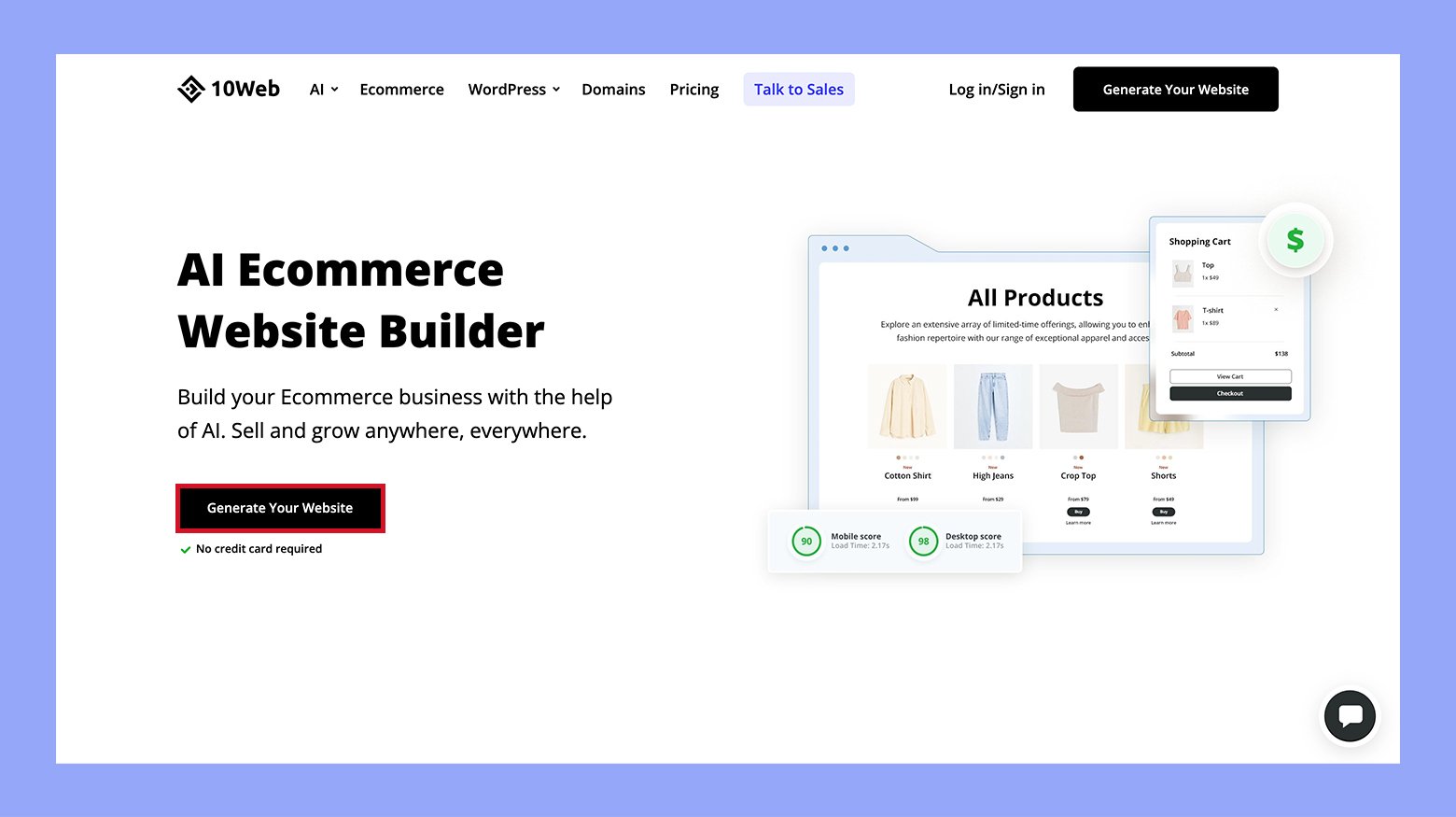
- From the options, choose Create a new website with AI

- Choose the option to create a website with an online store

- Enter your business type

- Fill in the name of your business and a short description. You can enhance the description using AI.

- Choose Yes to get a domain or click No if you have one already
- Enter your domain name if you have chosen No (optional).
- Click Next
- Set the 3 main products and categories. This section is pre filled by AI, however, you can edit it as needed

- Click Finalize to create your website
Once your ecom coffee store is created, you can start to populate your store with your products right from the 10Web dashboard. Click on the Ecommerce tab to the left of your 10Web dashboard to get started.
- Click on Products > Add New Product

- Fill in all the information about the coffee you are selling
- Add quality images and proper descriptions
- Make sure to assign it categories and subcategories.
- Include shipping information and costs.
- Once you are done filling in all the information, click Create to add the product to your shop.
Developing a marketing strategy
A solid marketing strategy is key for selling coffee online. Focus on leveraging social media and utilizing email marketing effectively to reach your audience and boost sales.
Leveraging social media
Social media platforms like Instagram, Facebook, and Twitter can be powerful tools in your marketing toolkit. Share visually appealing images and videos of your coffee products. People are attracted to high-quality photos and engaging content. Use hashtags relevant to the coffee industry to broaden your reach.
Engage with your audience by responding to comments and messages. Host giveaways or contests to generate buzz and gain followers. Collaborate with influencers who resonate with your target market. Influencers can help showcase your coffee to a larger audience and lend credibility to your brand.
Consider using paid advertising on social media to target specific demographics. Facebook and Instagram offer robust tools for creating targeted ad campaigns. Use analytics to track engagement and adjust your strategy based on what works best.
Email marketing and newsletters
Email marketing is another essential part of your strategy. Build an email list by offering incentives such as discounts or exclusive content to new subscribers. Segment your email list to send tailored content to different groups based on their interests or purchasing behavior.
Create engaging newsletters with updates about new products, promotions, or coffee-related content. Include eye-catching subject lines and well-designed email templates. Personalize your emails to make your audience feel valued and more likely to engage with your content.
Track metrics like open rates and click-through rates to see what resonates with your audience. Use this data to refine your approach and maximize effectiveness. Automated email campaigns can help nurture leads and convert them into loyal customers.

Looking to sell online?
Create your custom online store in minutes with 10Web AI Ecommerce Website Builder and take your business online.
Implementing SEO best practices
To sell coffee online successfully, implementing effective SEO strategies is crucial. SEO helps your business appear in search engine results, driving more traffic to your site.
Research keywords: Identify the keywords most associated with coffee sales. Use tools like Google Keyword Planner to find terms like “buy coffee online” or “best coffee beans.”
Create quality content: Write blogs and articles about coffee. Talk about different brewing methods, coffee types, or sustainable practices. Engaging content keeps visitors on your site longer.
Optimize product pages: Ensure your product descriptions contain relevant keywords. Include high-quality images and user-friendly descriptions. This helps search engines understand what you are selling.
Build backlinks: Partner with reputable coffee blogs and influencers. Ask them to link to your site. Quality backlinks increase your site’s authority and improve search rankings.
Use meta descriptions and alt text: Write clear meta descriptions for each page. Include keywords in the alt text for images. Both help search engines index your content more effectively.
Mobile optimization: Ensure your site looks good on mobile devices. Many customers use their phones to shop. Google also ranks mobile-friendly sites higher.
Track performance: Use tools like Google Analytics to monitor your site’s performance. See which keywords drive traffic and adjust your strategy as needed.
| SEO Tips | Benefits |
| Research keywords | Targeted traffic |
| Quality content | Increased engagement |
| Product page optimization | Better search visibility |
| Backlinks | Higher site authority |
| Meta text usage | Improved indexing |
| Mobile optimization | Higher Google ranking |
| Performance tracking | Data-driven strategy |
Following these practices helps improve your site’s visibility, attract more customers, and boost your coffee sales online.
Managing order fulfillment and shipping
To effectively manage order fulfillment and shipping for your coffee business, you need to focus on packaging, presentation, and choosing the right shipping partners.
Packaging and presentation
First, make sure your coffee is packaged properly. Use high-quality bags that keep your coffee fresh and aromatic. Bags with one-way valves are great because they allow gases to escape without letting air in. Consider using eco-friendly materials to appeal to environmentally conscious customers.
Labeling is crucial. Each bag should have clear labels with the coffee type, roast date, and any other relevant information. Attractive, well-designed labels catch the eye and can make a positive impression on customers.
Presentation also matters. How you present your coffee sets the tone for customer experience. Use packaging inserts, like thank-you notes or brewing tips, to create a memorable unboxing experience. Small details like this can help your brand stand out.
Choosing shipping partners
Selecting the right shipping partners is vital. Look for companies with good reputations for reliable and timely deliveries. You might start with well-known services like UPS, FedEx, or DHL.
Compare costs: Shipping costs can add up quickly. Compare rates between different services and consider factors like delivery speed, reliability, and package tracking.
International shipping: If you plan to ship internationally, make sure your shipping partner handles customs and duties efficiently. Research international shipping policies and choose partners familiar with shipping food products.
Tracking and customer service are also important. Choose partners that offer tracking services so your customers can monitor their orders. Good customer service from the shipping company helps resolve any issues quickly, ensuring a smoother experience.
Careful planning in these areas can ensure your coffee reaches customers fresh and on time.
Providing excellent customer service
Customer service is key to selling coffee online. Happy customers are more likely to return and recommend your products to others. Here are some essential tips to ensure great customer service:
- Be responsive: Answer inquiries and complaints quickly. Try to respond to emails and messages within 24 hours.
- Clear communication: Keep your customers informed about their orders. Provide tracking information and any updates promptly.
- Personal touches: Add a thank you note or small free sample to orders. These little extras can go a long way in making customers feel valued.
- Easy returns and refunds: Make it simple for customers to return products or get a refund. Clear policies can build trust and encourage more purchases.
- Reliable shipping: Make sure your coffee arrives on time and in good condition. Partner with reputable shipping companies.
Customer Service Tools
| Tool | Function |
| Live chat support | Immediate help for customer queries |
| CRM software | Manage customer relationships and histories |
| Email automation | Send order confirmations and updates |
| Feedback surveys | Gather customer opinions for improvement |
Tip: Always ask for feedback. Customer opinions can help you refine your services and products.
Remember: Exceptional service makes your customers feel appreciated and increases the chances they will return.
Analytics and performance monitoring
To effectively sell coffee online, monitoring your sales, website traffic, and customer feedback is crucial. By using the right tools and analyzing the data, you can make informed decisions to improve your business.
Tools for tracking sales and traffic
There are many tools available to track sales and website traffic. Google Analytics is a powerful tool where you can see detailed reports on visitor numbers, page views, and sales data. Setting up conversion tracking allows you to know which marketing efforts are driving sales.
E-commerce platforms like Shopify and WooCommerce also offer built-in analytics. These platforms can display real-time data on sales, customer behavior, and other key metrics.
Using heatmaps from tools like Hotjar helps you see where visitors click most on your site. This information can help you optimize the layout for better user experience.
Analyzing customer feedback
Listening to customer feedback is important for improving your coffee business. Collect reviews on your website or through third-party sites like Yelp or Google Reviews. Pay attention to what customers like and dislike about your products.
Surveys are another helpful method. Sending out short, targeted surveys after a purchase can give you insights into customer satisfaction. Tools like SurveyMonkey or Google Forms make this process easy.
Social media monitoring tools like Hootsuite can also be useful. They help you track mentions of your brand and engage with customers directly. Responding to feedback promptly shows you value customer opinions and can improve brand loyalty.
Scaling your online coffee business
Scaling your online coffee business involves several key steps. With careful planning and execution, you can grow your customer base and increase sales.
Expand your product line: Offering a variety of coffee blends, brewing equipment, and accessories can attract more customers. You might also consider seasonal or limited-edition products to create excitement.
Enhance your website: Ensure your website is user-friendly and mobile-optimized. Fast loading times, easy navigation, and a seamless checkout process are crucial. Consider adding features like customer reviews and product recommendations.
Utilize social media: Social media platforms can help you reach a broader audience. Regularly post engaging content, like brewing tips, coffee facts, and promotions. Interact with your followers to build a strong community.
Invest in marketing: A well-planned marketing strategy can boost visibility. Use email marketing, Google ads, and social media ads to target potential customers. Provide incentives such as discounts and loyalty programs.
Partner with influencers: Collaborate with influencers in the coffee niche. Their followers trust their recommendations, which can drive traffic and sales to your store. Ensure the influencers align with your brand values.
Improve customer service: Excellent customer service can set you apart from competitors. Provide multiple contact methods, like chat and email. Respond promptly to inquiries and resolve issues efficiently.
Track analytics: Regularly analyze your sales data and website traffic. Use tools like Google Analytics to track customer behavior. This data can help you make informed decisions about marketing and product offerings.
Optimize inventory management: Effective inventory management ensures you can meet demand without overstocking. Use software tools to track stock levels and automate reordering. This helps maintain a smooth supply chain.
Explore international markets: Consider expanding your business to international markets. Research market demand and shipping logistics. Adapting your website for different languages can also help attract global customers.
Stay innovative: Keep an eye on industry trends and continuously innovate. Whether it’s new brewing methods or eco-friendly packaging, staying ahead of trends can keep your business competitive.
Conclusion
Starting an online coffee business can be highly profitable due to the growing demand for specialty and gourmet coffee. This article covered essential aspects such as identifying your target audience, sourcing quality coffee, and diversifying your product offerings. It also emphasized the importance of setting up a user-friendly online store, effective marketing strategies, and excellent customer service. By following these guidelines, you can create a successful online coffee business that stands out in the competitive market. This knowledge equips you with the tools to attract and retain customers, ensuring sustained growth and profitability.


